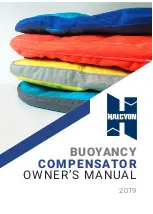
Micro-Adjust Feature
14
2 3 4 5
Fence Extrusion
T-Slot
Fence
Extrusion
Step
Set micro-adjust with dial caliper.
Set micro-adjust with dial
caliper or feeler gauge.
Setting the Micro-Adjust
When using the micro-adjust, it is much easier to set your angle on
the left side of the scale, as pictured above. If you must use the
right side of the scale, you will need to remove the positioning block
from your fence and you will be moving the fence a lot that may
affect the accuracy of your micro-adjust setting.
Setting the Micro-Adjust using Feeler Gauges
1) Set the angle to the nearest 1/10 deg.
2) Place a small block of wood on the miter gauge & use a
spring clamp to hold the fence in position.
3) Loosen the plastic knobs that attach the auxiliary fence.
5) Turn out the plastic micro adjuster screw until it pushes
against the fence. You may need to use a 3/16” Allen
wrench to turn the micro adjuster screw against the
pressure of the spring clamp. Keep turning it until you can
just insert the correct size feeler gauge between the fence
and the miter gauge.
4) Tighten the plastic knobs.
6) Try to remove the Feeler Gauge. If it just slides out, you are
done. However, you may have to slightly loosen the plastic
knob next to the micro adjuster and turn out the micro
adjuster screw to get the exact setting.
Setting the Micro-Adjust using a Dial Caliper
1) Set the fence even with the edge of the miter gauge.
2) Set the angle to the nearest 1/10 deg.
3) Place a small block of wood on the miter gauge & use a
spring clamp to hold the fence in position.
4) Loosen the plastic knobs that attach the auxiliary fence.
5) Place a dial caliper in the notch and zero the scale.
6) Turn out the plastic micro adjuster screw until it pushes
against the fence. Keep turning it until the dial indicator
reads the correct spacing. You may need to use a 3/16”
Allen wrench to turn the micro adjuster screw against the
pressure of the spring clamp.
7) Tighten the plastic knobs and remove the spring clamp.
How the Micro-Adjust Works
The micro-adjust mechanism works by changing the spacing between
the fence and the miter gauge. For every 0.001” of space you add,
you increase the angle 1/100 deg. You add the space by turning a
nylon screw that pushes the fence away from the miter gauge.
Reality Check
Before taking the time to set the micro-adjust, do a reality check to
see if the 1/100 deg. will really show. 1/100 deg. is a very fine adjust-
ment and is seldom necessary on most woodworking projects. 1/100
deg. is only a 0.001” gap over a 5.7” length of cut.
Example #1:
7 Sided Jewelry Box
The angle you need for a seven sided box is 25.71 deg. The sides of
the box are 1/2” thick. Micro-Adjusting for the 1/100 deg. would
eliminate a gap of less than 1/10,000.” Forget it, a gap that small is
meaningless. Just set your miter gauge to 25.7 deg. and go to work
confident you will have a gap free project.
Example #2:
21 Sided Top for 7 Sided Jewelry Box
Now let’s assume you are going to put a very fancy top on the 7 sided
jewelry box. You are using 3 different woods on each side to create a
burst of color, which creates 21 segments.
The angle you need for 21 segments is 8.57 deg. Each segment is 12”
wide. Micro-adjusting the 7/100 deg. will eliminate a gap of 0.015” on
each joint. This calculation assumes each joint will have an equal gap.
In real life, the gaps will be much larger. When you clamp the seg-
ments together, the clamps will usually push two sides tightly togeth-
er, leaving twice the gap on the next joint. That is a gap of .029”. You
can put six sheets of paper into a gap that large. Six sheets of paper is
a gap that will definitely show.
Many woodworkers will try to fill gaps like this with glue or putty. But
if you can build pieces that fit together tightly, people will definitely
notice the difference!
Summary
Take the time to set the micro-adjust on wide boards, especially if you
need to add 3/100 deg. or more. Don’t bother on thin pieces or if you
only need to add 1/100 deg.
The micro-adjust is designed so that the nylon screws line up
with the t-track slot. You have to turn the nylon screws a long
way before they actually engage the auxiliary fence and start
to change the angle. This design minimizes the chances you will
accidentally add an adjustment to the angle you are setting.
Design Note


































